SCIENCE REPORTER SUMMARY: DECEMBER 2024
ARTICLE 1:
- ARTICLE 1:
- ARTICLE 2:
- ARTICLE 3
- ARTICLE 4
- ARTICLE 5
- ARTICLE 6
- ARTICLE 7
- ARTICLE 8
- ARTICLE 9
- Minamata Convention and Mercury Emission from Coal-Fired Power Plants in India
- Introduction to Mercury Pollution and the Minamata Convention
- Mercury in the Environment
- Major Sources of Mercury Pollution
- Mercury Emissions in Power Plants
- Measures Under the Minamata Convention
- Technologies for Mercury Control
- Present Scenario in India
- Challenges and the Way Forward
- ARTICLE 10
- Empowering India’s Electric Future through Lithium-ion Battery Technology
- India’s Leap Towards Sustainable Energy
- Milestones in Indigenous Lithium-Ion Battery Production
- Collaborative Efforts and Forward-Looking Strategies
- Overcoming Challenges in Lithium-Ion Technology
- Economic and Environmental Impact
- Building a Self-Sustaining Ecosystem
- Vision for 2030: Self-Reliance in Energy Solutions
- Inspiring Global Sustainability
- ARTICLE 11
- ARTICLE 12
- NEWS IN BRIEF
Geospatial Technology
Introduction to Geospatial Data
- Geospatial data refers to information related to the geographical aspects of specific locations, encompassing elements like addresses, cities, and postal or zip codes.
- It integrates datasets from diverse sources such as census data, satellite imagery, weather records, geotagging, and statistical data.
- The roots of geospatial data trace back to ancient cartography, with historical evidence from as early as 1,400 BC in Egypt.
- Over time, technological advancements in aerial photography, satellite imaging, and geo-mapping have revolutionized the way geographical information is captured, analyzed, and interpreted.
Components of Geospatial Technology
Geospatial technology employs a combination of tools, techniques, and software to manage spatial data. Three primary components are:
- Global Positioning System (GPS): Widely used for navigation and precise location tracking, as exemplified by applications like Google Maps.
- Geographic Information Systems (GIS): Facilitates the creation of detailed maps and integrates diverse data layers such as topography, land use, and population.
- Remote Sensing: Collects data from satellites or aircraft, providing crucial information on weather patterns, environmental changes, and agricultural conditions.
These technologies collectively enable the precise collection, storage, and analysis of spatial data, enhancing their applicability across various domains.
Applications in Diverse Fields
Geospatial technology has found significant applications across multiple sectors:
Urban Planning and Governance
- Geospatial tools aid in disaster management, urban planning, and smart city development.
- They provide insights for infrastructure planning, resource allocation, and digital governance initiatives.
Agriculture and Rural Development
- By offering detailed information on soil characteristics, crop health, and weather patterns, geospatial technology supports better decision-making in agriculture.
- It helps optimize crop yields, analyze soil fertility, and manage water resources efficiently.
Natural Resource Management
- Geospatial technology plays a vital role in monitoring natural resources, such as water and forests, and assessing the impacts of climate change.
- It helps track deforestation, manage ecosystems, and monitor biodiversity conservation efforts.
Healthcare and Public Health
- From mapping disease outbreaks to identifying environmental health risks, geospatial technology significantly contributes to healthcare.
- It supports the allocation of resources and the monitoring of health conditions in real time.
Transportation and Logistics
- The transportation and logistics industry has witnessed a paradigm shift due to geospatial advancements, enabling route optimization, fleet management, and efficient goods delivery.
ARTICLE 2:
Selective Co-Cultivation of Some Crops Offers Multiple Benefits
Ancient Agricultural Practices and Their Timeless Relevance
- While advancements in science and technology have revolutionized modern agriculture, ancient farming practices continue to hold significant value.
- Practices like crop rotation and terracing remain integral to sustainable agriculture today.
- One such ancient practice, Milpa, originating from the Mayan civilization, is still employed in Mexico and Central America.
- Milpa involves co-culturing maize, beans, and squash—dubbed the “three sisters”—to enhance crop yield.
- Scientifically, this method demonstrates remarkable synergy: beans fix nitrogen in the soil, maize provides structural support for beans, and squash retains soil moisture and suppresses weeds.
Scientific Insights into the “Three Sisters” System
- Recent studies, including one highlighted in Science (August 30, 2024) and later in Agriculture, Ecosystem, and Environment (September 2024), reveal that the benefits of the three-sisters system extend beyond resource sharing.
- These crops also interact to reduce pest damage. Maize emits volatile chemicals when attacked by pests, which not only increase toxin levels in its own leaves but also in neighboring plants.
- Moreover, maize signals nearby beans to secrete sugar-rich nectar, attracting ants and wasps.
- These insects act as natural pest controllers, feeding on or parasitizing caterpillars like the army worm, thus protecting both beans and maize.
- Enhanced nectar sugar concentration also extends the lifespan of these beneficial insects, amplifying pest control.
Mixed Cultures vs. Monocultures
- Experiments by entomologists demonstrate that crops grown in monoculture are more vulnerable to pests and yield less compared to mixed planting systems.
- Their findings suggest that mixed cultures reduce reliance on chemical pesticides, offering a more sustainable and profitable alternative.
- According to ecologists, this research underscores the benefits of biodiversity in agricultural systems, emphasizing the importance of integrating crop diversity into farming practices.
Challenges and Future Directions
- Despite the benefits, not all crop combinations are successful. The effectiveness of mixed cultures depends on factors such as plot size, weather conditions, pest populations, and the types of volatile compounds emitted by the plants.
- Research highlights that complex terpenoids among these compounds play a critical role in inter-plant communication and pest deterrence.
- Identifying optimal crop pairings and their biochemical interactions can help farmers achieve better yields while minimizing the use of chemical fertilizers and pesticides.
ARTICLE 3
Single Cell Transcriptomics Prospects in Plant Biology
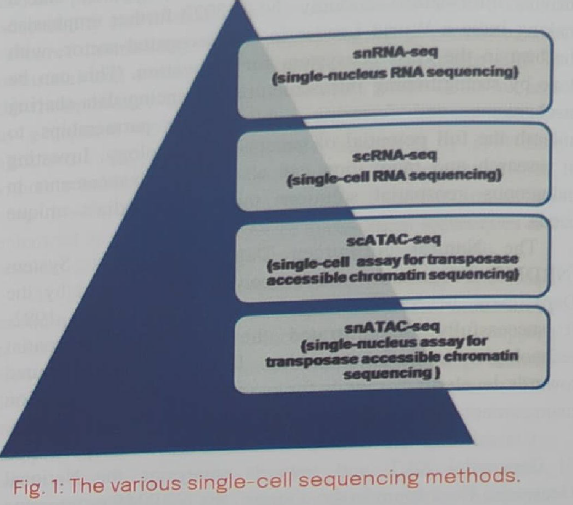
Introduction to Single-Cell Transcriptomics
- Advancements in next-generation sequencing (NGS) technologies have deepened our understanding of biological systems.
- A notable breakthrough is single-cell transcriptomics, which analyzes the transcriptome (mRNA molecules) of individual cells.
- This approach provides insights into genetic mechanisms underlying cellular differentiation—a key developmental process in living organisms.
- Unlike traditional bulk RNA sequencing, single-cell RNA-seq offers high-resolution, cell-specific data on a genomic scale, addressing the intricacies of cellular development.
Evolution of Single-Cell Technologies
- The journey of single-cell technologies began in 1972 with Giemsa staining for karyotype analysis.
- The first report of single-cell transcriptomics emerged in 2009, followed by rapid advancements in the field.
- Between 2015 and 2023, studies on single-cell RNA profiling in plants increased more than 20-fold.
- These technologies have revolutionized the understanding of cell-specific gene expression and its spatial and temporal regulation, particularly in response to external stimuli like pathogens.
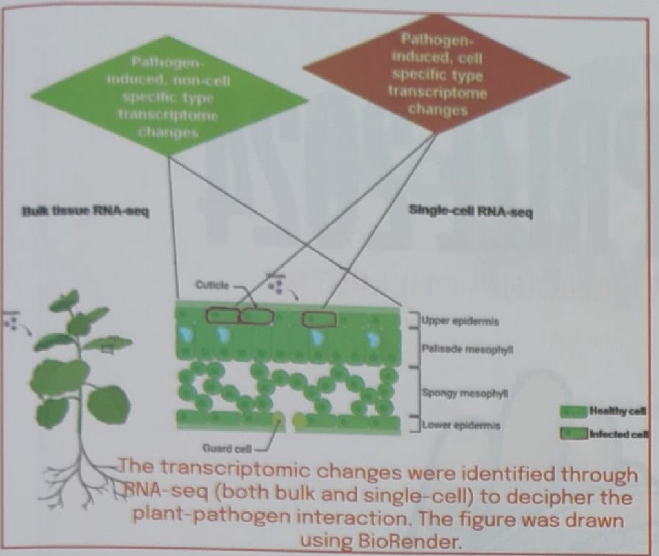
Applications of Single-Cell Transcriptomics
1. Understanding Cellular Development Mechanisms
Single-cell RNA sequencing has been pivotal in deciphering organ development processes. For example:
- In Arabidopsis, scRNA-seq studies uncovered previously unknown cell subclasses and signaling networks during root development, leading to the creation of the first Plant Cell Atlas (PCA).
- scRNA-seq has also been employed to study cotyledon development and maize inflorescence, generating high-resolution maps of cell differentiation and signaling.
2. Analyzing Plant Responses to Biotic and Abiotic Interactions
Plants face numerous challenges from environmental stresses. Single-cell transcriptomics has helped elucidate plant responses, including:
- Drought stress and low phosphate conditions.
- Wounding, as seen in Arabidopsis, where transcriptional networks were identified in wounded leaves, aiding adventitious root formation.
3. Enhancing Gene Function Annotation
Understanding the function of homologous genes is crucial for studying evolutionary relationships among plant species. Single-cell RNA-seq has enabled:
- Precise identification of homologous genes.
- Validation of conserved cell type-specific gene expressions, particularly in Arabidopsis, strengthening functional annotations and their biological relevance.
Future Prospects
- Single-cell sequencing technologies are poised to address many unresolved complexities in plant biology.
- By offering unparalleled insights into cellular mechanisms, environmental interactions, and gene functions, this field holds the promise of driving innovations in agriculture, biotechnology, and plant science in the near future.
ARTICLE 4
MAL System: 47th blood group system
Components and Formation of Blood
- Blood, a specialized human body fluid, comprises four main components: plasma, red blood cells (erythrocytes), white blood cells (leukocytes), and platelets.
- The formation of blood cells, a process called hematopoiesis, occurs in the bone marrow from hematopoietic stem cells.
- Blood groups are classified into systems based on specific antigens on the surface of red blood cells.
- The ABO system, combined with the presence or absence of the Rh factor, categorizes blood into four main groups: O, A, B, and AB, which vary in frequency across populations.
Discovery of a New Blood Group: MAL
- Researchers from the NHS Blood and Transplant (NHSBT) and Bristol University recently identified a novel blood group system, MAL, marking the 47th known blood group system.
- This discovery, published in the journal Blood, resolves a 50-year mystery surrounding the AnWj blood group antigen, first identified in 1972 in a pregnant woman.
- The MAL blood group sheds light on the genetic and molecular basis of this rare antigen.
Role of MAL Protein and Its Clinical Significance
- The MAL blood group is associated with the MAL protein, a hydrophobic proteolipid expressed by the MAL gene in T lymphocytes.
- The MAL protein plays critical roles in T-cell signal transduction and the biogenesis of myelin in the nervous system, essential for proper nervous function.
- A mutation or deletion in the MAL gene leads to an AnWj-negative blood type, as seen in individuals carrying two mutated copies of the MAL gene.
- This condition requires precise identification during blood transfusions for AnWj-negative individuals to avoid complications.
Advancements in Genotyping for Rare Blood Groups
- The development of a new genotyping assay enables the identification of rare AnWj-negative individuals within a population.
- This innovation aids in providing better care for patients with rare blood types and ensures well-matched blood donors are available for transfusions.
- The discovery of the MAL blood group underscores the importance of continued research in hematology for improving transfusion medicine and patient care.
ARTICLE 5
2024 Noble Prize in Physics
Recognizing AI Pioneers
- This year’s Nobel Prize in Physics celebrates the groundbreaking contributions of John J. Hopfield and Geoffrey E. Hinton in advancing machine learning and Artificial Neural Networks (ANN).
- The ceremony, held annually on 10 December, coincides with the death anniversary of Alfred Nobel, the prize’s founder.
- While both laureates acknowledge the transformative potential of AI, they have also expressed concerns regarding its potential risks, including the possibility of machines overpowering humans.
- Hinton, known as the “godfather of AI,” notably stepped away from Google in 2023 to voice these concerns.
The Evolution of Machine Learning and ANN
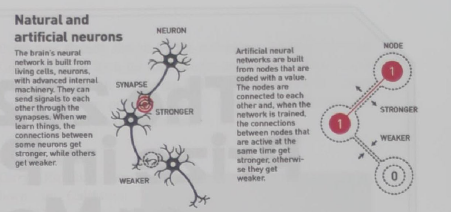
- Machine learning, rooted in the 1940s, has evolved over decades into a versatile tool enabling machines to think and act like humans.
- Artificial Neural Networks (ANN), inspired by the functioning of the human brain, extend these capabilities further.
- The concept of ANN emerged in 1943 with the work of neurophysiologist Warren McCulloch and mathematician Walter Pitts, followed by the first successful neural network by Belmont Farley and Wesley Clark in 1954.
- ANN operates through artificial neurons, or nodes, that mimic the communication and learning processes of human brain neurons, strengthening connections through a binary-coded learning process.
Contributions of Hopfield and Hinton
Hopfield and Hinton made significant strides in machine learning and ANN, shaping its development.
- John J. Hopfield introduced the Hopfield network in 1981, where every neuron is connected to others, allowing for tasks like denoising images by minimising analogous magnetic energy. His work leveraged principles of statistical physics and Hebbian learning, which operates on the principle that “neurons that fire together wire together.”
- Geoffrey E. Hinton, building on Hopfield’s work, developed the Boltzmann machine, a cognitive tool capable of identifying patterns in data by minimising an energy function. This advancement laid the foundation for modern AI applications.
ANN and Interdisciplinary Roots
- ANN draws from diverse fields such as statistical physics, neurobiology, and cognitive psychology. Its development in the 1980s, led by researchers like Hopfield and Hinton, paved the way for the machine learning revolution of the 2010s.
- These technologies now underpin advancements in AI, from data analysis to cognitive tasks, demonstrating their immense scientific and practical value.
Impact and Legacy
- The Nobel Committee’s recognition of Hopfield and Hinton underscores the transformative impact of their work.
- Their contributions not only revolutionized computational and cognitive sciences but also reshaped how machines learn and interact.
- As AI continues to expand, their pioneering research serves as a cornerstone for future innovations while reminding humanity to balance its potential with caution.
ARTICLE 6
2024 Noble Prize in Medicine
Revolutionizing Gene Regulation
- The Nobel Prize in Physiology or Medicine 2024 was awarded to Victor Ambros and Gary Ruvkun for their groundbreaking discovery of microRNAs (miRNAs) and their role in post-transcriptional gene regulation.
- Their research has significantly enhanced our understanding of how genes are expressed and regulated, shedding light on processes crucial for cellular function and development.
- These findings promise profound implications for medicine, agriculture, and evolutionary biology.
Understanding Gene Regulation
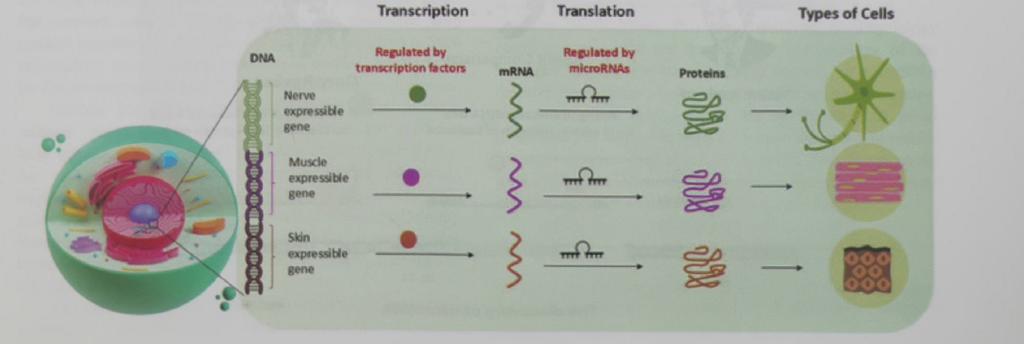
Gene regulation, the process of turning genes on or off, determines how cells with identical DNA exhibit diverse functions. Traditionally, gene regulation was understood to occur at two levels:
- Transcriptional regulation, where transcription factors control the copying of DNA into messenger RNAs (mRNAs).
- Epigenetic modifications, involving chemical changes to DNA that influence gene expression.
The discovery of microRNAs introduced a third dimension: post-transcriptional regulation, where microRNAs inhibit the production of proteins from mRNAs, rather than interfering with the transcription process itself.
The Discovery of MicroRNAs
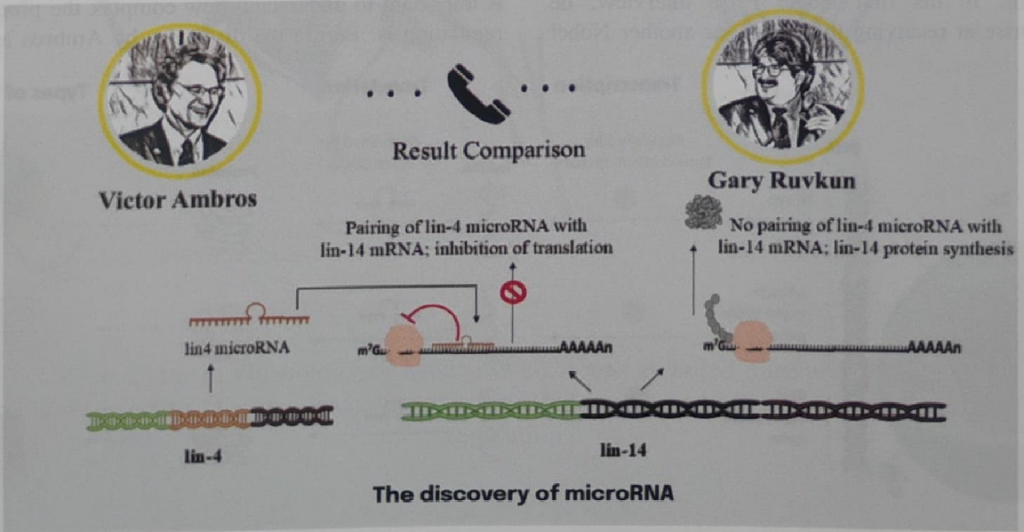
- Ambros and Ruvkun’s pioneering research began in the late 1980s with studies on the tiny nematode worm C. elegans.
- They discovered that the lin-4 gene produced a small RNA molecule that regulated the lin-14 gene by binding to its mRNA and blocking protein production.
- This mechanism, termed post-transcriptional gene regulation, marked the first identification of microRNAs as novel regulators of gene expression.
- Initially dismissed as a phenomenon unique to C. elegans, the discovery of the let-7 microRNA, present across species, validated the universal significance of microRNAs, catalyzing further research.
How MicroRNAs Work
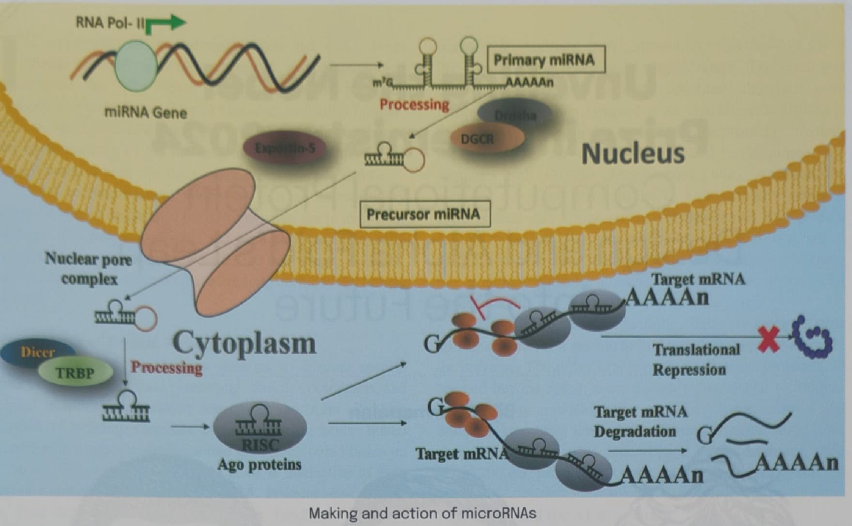
MicroRNAs are produced through a multi-step process:
- Initiation in the nucleus: RNA polymerase II copies microRNA genes into pri-miRNAs.
- Processing by Drosha: Pri-miRNAs are chopped into smaller pre-miRNAs.
- Export to cytoplasm: Pre-miRNAs move out of the nucleus via exportin 5.
- Final processing by Dicer: Pre-miRNAs are processed into mature microRNAs, which then bind to the RNA-induced silencing complex (RISC) to inhibit specific mRNAs or degrade them.
This intricate process ensures precise regulation of protein production, vital for cellular and developmental functions.
Impacts of MicroRNA Discovery
MicroRNAs play essential roles across diverse biological processes:
- Disease Insights: Imbalances in microRNAs are linked to diseases like cancer and Alzheimer’s. MicroRNAs can inhibit or promote cancer cell growth, and specific ones contribute to amyloid protein buildup in Alzheimer’s.
- Medical Applications: Synthetic microRNAs are being tested as therapies, and their use as biomarkers shows promise for non-invasive disease diagnosis.
- Agricultural Advancements: MicroRNA research is revolutionizing agriculture. Genetically modified farm animals produce allergen-free milk, while crops are being developed to be climate-resilient and productive.
- Evolutionary Insights: MicroRNAs, conserved across species, provide critical clues to evolutionary processes, reflecting their fundamental role in life’s basic metabolism.
Perspectives on the Discovery
- The discovery of microRNAs has redefined our understanding of gene regulation, highlighting their importance in development, evolution, and disease.
- The 2024 Nobel Prize celebrates the transformative impact of this research, paving the way for innovations in medicine, agriculture, and environmental sustainability.
- From creating climate-resilient crops to developing novel disease treatments, the potential of microRNA research continues to inspire progress across multiple fields.
ARTICLE 7
Revolutionizing Molecular Science: The 2024 Nobel Prize in Chemistry
- The 2024 Nobel Prize in Chemistry was awarded to David Baker, Demis Hassabis, and John Jumper, honoring their groundbreaking advancements that have redefined biology, chemistry, and computational science.
- This work has ushered in a new era of molecular biology by enabling the precise prediction and design of proteins with unprecedented functions.
- These innovations pave the way for revolutionary breakthroughs in medicine, biotechnology, and synthetic biology, offering solutions for previously insurmountable challenges like drug development, vaccine design, and disease treatment.
The Genesis of Protein Structure Prediction
- Proteins, essential molecules for life, execute diverse cellular functions. Their unique sequences of amino acids fold into intricate three-dimensional structures essential for their roles.
- While the relationship between amino acid sequences and their structures intrigued scientists for decades, solving the mystery of protein folding remained elusive.
- Groundbreaking insights emerged in the 1950s when John Kendrew and Max Perutz used X-ray crystallography to model protein structures, earning a Nobel Prize in 1962.
- A significant breakthrough came in 1962 with Christian Anfinsen’s discovery that amino acid sequences themselves encode folding instructions, work that garnered another Nobel Prize in 1972.
- Despite these achievements, predicting protein structures remained daunting, given the astronomical number of possible configurations.
- Experimental techniques like X-ray crystallography and NMR spectroscopy were labor-intensive and limited in scope, solving only a fraction of the millions of known protein sequences.
AlphaFold and the AI Revolution
- In 2020, the advent of AlphaFold, an AI developed by Demis Hassabis, John Jumper, and the DeepMind team, transformed protein structure prediction.
- Using deep learning, AlphaFold accurately modeled protein structures with experimental-level precision, solving decades-old challenges in mere hours.
- Its algorithms leverage vast protein databases to predict folding patterns, opening the door to advancements in drug discovery, genetic research, and biotechnology.
- The impact was immediate and profound. AlphaFold mapped the structures of the entire human proteome and numerous other organisms, creating databases with millions of protein structures accessible to researchers worldwide.
- This innovation enables targeted drug therapies and a deeper understanding of diseases like Alzheimer’s and cancer.
- The Nobel committee lauded AlphaFold as a “complete revolution,” underscoring its transformative potential.
David Baker and Computational Protein Design
- While AlphaFold predicts natural protein structures, David Baker’s work focuses on designing entirely new proteins.
- His pioneering efforts in computational protein design, particularly with the Rosetta software, initiated the field of de novo protein design.
- In 2003, Baker’s team created Top7, the first synthetic protein with a novel shape, demonstrating the ability to engineer proteins from scratch.
- Rosetta designs amino acid sequences that fold into predetermined structures, enabling applications in synthetic biology and medicine.
- Artificial proteins designed by Baker’s team have catalyzed chemical reactions, targeted specific molecules, and assembled into larger structures.
- These innovations have laid the groundwork for creating novel enzymes, sensors, and therapeutic proteins, revolutionizing fields from drug delivery to environmental sustainability.
Transformative Impacts on Medicine and Biotechnology
- The convergence of protein prediction and design has profound implications for medicine and biotechnology.
- Misfolded or malfunctioning proteins often underlie diseases such as Alzheimer’s and cancer.
- With tools like AlphaFold and Rosetta, scientists can develop targeted treatments, such as highly specific protein-based drugs with fewer side effects.
- Baker’s lab also contributed to vaccine innovation, notably during the COVID-19 pandemic, by designing synthetic proteins for nanoparticle vaccines.
- Beyond medicine, custom-engineered proteins are driving advancements in synthetic biology, including self-assembling nanomaterials and biosensors for environmental and medical applications.
- For instance, protein-based biosensors can detect opioids like fentanyl with unparalleled precision.
Challenges and Future Directions
- Despite these advancements, significant challenges remain. Proteins are dynamic molecules, and predicting their behavior in different environments or within large protein complexes is still an ongoing effort.
- Understanding these interactions is crucial for addressing complex diseases. Similarly, engineering proteins with highly specialized functions, such as stimuli-responsive proteins or complex enzymes, continues to be a frontier for research.
- The recognition of Baker, Hassabis, and Jumper underscores the transformative potential of interdisciplinary collaboration.
- The fusion of biology, chemistry, and artificial intelligence has already revolutionized science and promises to drive innovations that will shape the future of medicine, biotechnology, and beyond.
ARTICLE 8
Global Warming: Is Geo engineering the solution
Global Warming and the Urgency for Action
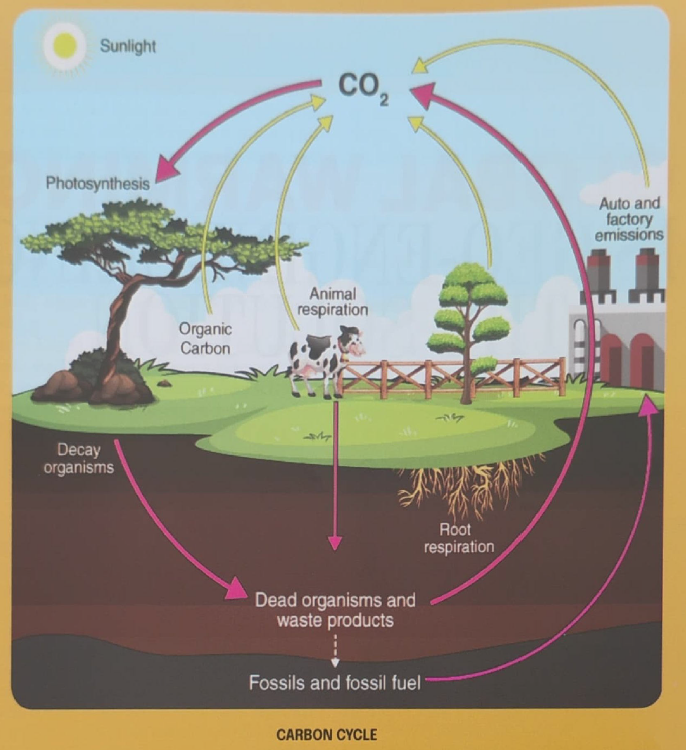
- The United Nations Environment Programme’s 2022 report, The Closing Window, confirmed a sobering reality: achieving the goal of limiting global warming to 1.5°C above pre-industrial levels is now nearly impossible based on current 2030 commitments.
- The alternative goal of 2°C is attainable only if all nations adhere to their net-zero pledges—an uncertain prospect given the ongoing trends.
- Even halting carbon dioxide emissions today would not immediately reverse warming due to the long-lasting effects of accumulated greenhouse gases.
- Moreover, surpassing 1.5°C risks triggering tipping points in the climate system, such as the sudden release of carbon dioxide and methane from thawing Arctic permafrost.
- These challenges underscore the necessity of not only halting global warming but actively reversing it.
Traditional Approaches and Their Limitations
- Efforts to mitigate climate change, such as reforestation, transitioning to renewable energy, and creating emission-free industries, have progressed but remain insufficient to meet the urgent timeline.
- While essential, these measures are slow to produce the necessary results. This has prompted scientists to explore geo-engineering—technological interventions designed to mitigate or reverse climate change on a global scale.
- These strategies include increasing the Earth’s solar reflectance and removing carbon dioxide from the atmosphere.
Enhancing Solar Reflectance
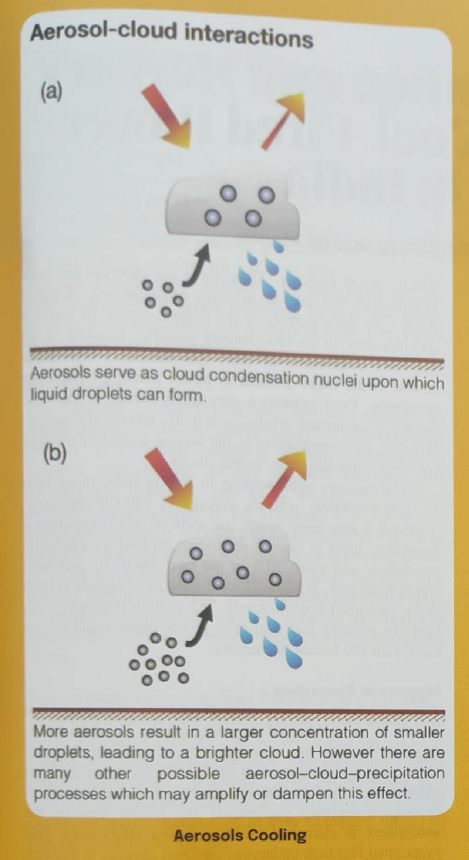
Geo-engineering methods aimed at reducing the Earth’s heat absorption focus on increasing solar reflectance.
- Stratospheric Aerosol Injection: This method involves dispersing sulphate aerosols into the stratosphere to scatter sunlight and reduce global temperatures, mimicking cooling effects observed after volcanic eruptions like Mount Tambora (1815) and Mount Pinatubo (1991). While simulations show promising results, large-scale implementation remains untested.
- Albedo Enhancement: Techniques include marine cloud brightening, spraying seawater to increase cloud reflectivity, and whitening urban surfaces like rooftops and pavements to reflect sunlight.
- Space Reflectors: Proposals include deploying millions of reflective objects beyond Earth’s stratosphere to deflect sunlight, potentially reducing global temperatures by 2-4%.
These methods, while innovative, require further refinement and testing before large-scale application.
Removing Carbon Dioxide from the Atmosphere
Carbon dioxide removal focuses on extracting atmospheric CO₂ and securely storing it.
- Carbon Burial: This involves capturing CO₂ from industrial emissions and storing it underground or in deep oceans. While promising, risks include leaks and storage instability.
- Ocean Liming: Adding calcium or sodium hydroxide to oceans could enhance their CO₂ absorption capacity.
- Ocean Fertilisation: Introducing nutrients like iron to stimulate phytoplankton growth, which absorbs CO₂, could sequester carbon at the ocean floor.
- Direct Air Capture: Using “artificial trees” or scrubbing towers to chemically remove CO₂ from the air offers potential for large-scale sequestration.
Despite their potential, these methods are resource-intensive and carry ecological risks that must be carefully evaluated.
Risks and Challenges of Geo-Engineering
- While geo-engineering offers groundbreaking solutions, it is fraught with risks. Stratospheric aerosol injection could alter precipitation patterns, reduce crop yields, and increase acidic rain, exacerbating existing ecological challenges.
- Space reflectors might inadvertently accelerate Arctic ice melting. Ocean-based methods, like fertilisation and liming, could disrupt marine ecosystems.
- Additionally, carbon burial and air capture face long-term storage challenges.
These uncertainties highlight the need for extensive testing and monitoring before deploying geo-engineering solutions on a global scale.
The Case for Nature-Based Solutions
- Despite the promise of geo-engineering, the safest and most sustainable approach remains large-scale afforestation and marine ecosystem restoration.
- Reforestation could sequester up to 85 gigatons of CO₂ by 2050, while protecting marine ecosystems enhances their natural carbon capture capabilities.
- These methods are proven, low-risk, and essential complements to any technological interventions.
ARTICLE 9
Minamata Convention and Mercury Emission from Coal-Fired Power Plants in India
Introduction to Mercury Pollution and the Minamata Convention
- Globally, numerous environmental conventions aim to mitigate harmful pollutants, including the Stockholm Convention, Basel Convention, and Montreal Protocol.
- Among them, the Minamata Convention, adopted by the United Nations in 2013, focuses on the environmental and health impacts of mercury.
- Named after the 1956 mercury poisoning incident in Minamata Bay, Japan, this convention seeks to control and reduce mercury emissions.
- India joined the convention in 2014, ratifying it in 2018, signaling its commitment to addressing mercury pollution.
Mercury in the Environment
- Mercury is a neurotoxic metal found in everyday items like thermometers and CFL bulbs.
- Once released into the environment, mercury transforms into methylmercury, a toxic compound that accumulates in fish and wildlife, entering the food chain and posing severe risks to human health.
- Mercury is highly stable and can travel long distances before depositing on land and water, making it a global pollutant.
Major Sources of Mercury Pollution
- Key sources of mercury contamination include products like thermometers and fluorescent bulbs, industrial processes, and artisanal gold mining. However, coal combustion in power plants remains the largest source in India.
- Despite its low mercury concentration, the massive scale of coal combustion in power plants leads to significant emissions.
- India’s dependency on coal for approximately 70% of its electricity generation contributes to over 100 tonnes of mercury emissions annually.
Mercury Emissions in Power Plants
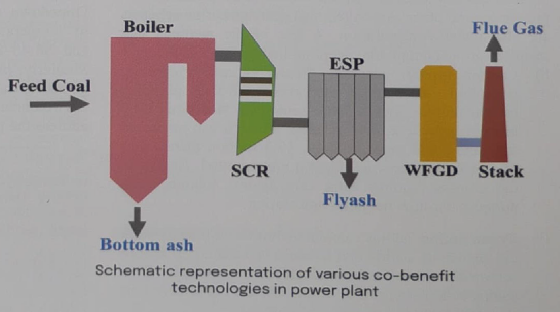
- When coal is combusted in power plants, mercury is released in various forms—elemental, oxidized, and particulate mercury—depending on factors like coal quality and pollution control systems.
- Elemental mercury is especially concerning due to its stability and long travel range, impacting environments far from the source.
Measures Under the Minamata Convention
- The Minamata Convention outlines measures to reduce mercury emissions, including quantified goals, emission limits, multi-pollutant control strategies, best practices, and alternative reduction techniques.
- In India, efforts to comply include developing technologically advanced power plants, closing older facilities, and adopting air pollution control devices (APCDs).
Technologies for Mercury Control
- Technologies like Electrostatic Precipitators (ESP) and Flue Gas Desulfurization (FGD) help control mercury emissions indirectly.
- SCR (Selective Catalytic Reduction) converts elemental mercury into a removable form, while Activated Carbon Injection (ACI) directly adsorbs mercury.
- Although promising, many of these technologies are still under development or implementation in India.
Present Scenario in India
- India has introduced new environmental norms, including a mercury emission cap of 0.03 mg/Nm³ for power plants.
- Most plants are equipped with ESPs for particulate mercury control, while FGD installations are progressing.
- The energy sector is gradually shifting toward cleaner technologies like supercritical boilers and renewable energy, reducing dependence on coal and associated mercury emissions.
Challenges and the Way Forward
- Despite progress, several challenges persist, such as delays in installing pollution control devices like FGDs, high implementation costs, and reliance on coal.
- Renewable energy, while expanding, cannot yet meet India’s energy demands. To mitigate mercury pollution effectively, stricter emission limits, efficient monitoring, timely installation of control devices, and stronger enforcement of environmental regulations are crucial.
- These measures will protect public health and the environment from mercury’s harmful effects.
ARTICLE 10
Empowering India’s Electric Future through Lithium-ion Battery Technology
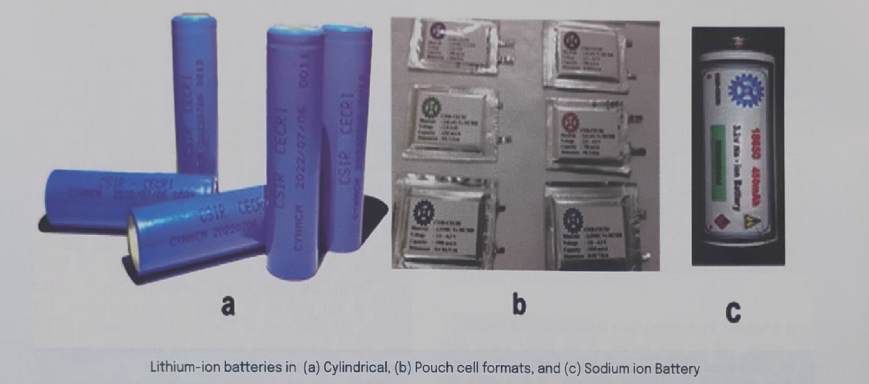
India’s Leap Towards Sustainable Energy
- As the world transitions to sustainable energy, India is advancing its lithium-ion battery technology through the ICeNGESS project, led by CSIR.
- This initiative focuses on developing a robust, indigenous ecosystem for lithium-ion battery production, strengthening India’s energy security, and reducing its dependence on fossil fuels.
Milestones in Indigenous Lithium-Ion Battery Production
- Spearheaded by CSIR-CECRI, the ICeNGESS project has already achieved a major milestone with the inauguration of an 18650-type cylindrical Li-ion battery fabrication facility in Chennai, capable of producing 1,000 cells daily.
- This facility bridges the gap between research and commercial production, forming the foundation for large-scale manufacturing in Phase Two.
- It empowers Micro, Small, and Medium Enterprises (MSMEs) to adopt local fabrication techniques, thereby boosting India’s industrial capacity.
Collaborative Efforts and Forward-Looking Strategies
- The project emphasizes collaborations with industry leaders like Tata Chemicals Ltd (TCL), leveraging expertise to accelerate progress.
- Additionally, it explores next-generation energy storage solutions, including sodium-ion batteries and supercapacitors.
- This future-focused approach ensures India stays at the forefront of sustainable energy innovation.
Overcoming Challenges in Lithium-Ion Technology
- While remarkable progress has been made, challenges such as securing reliable lithium supplies and building a skilled workforce persist.
- Ongoing research into alternative battery technologies and investments in workforce training programs offer potential solutions.
- These efforts are crucial for meeting the growing demand for energy storage systems and achieving self-reliance.
Economic and Environmental Impact
- The ICeNGESS project is poised to significantly impact India’s economy and environment. By fostering a domestic supply chain for lithium-ion components, it reduces reliance on imports and promotes cost-effective production, potentially lowering battery costs by 50%.
- This cost reduction will make electric vehicles (EVs) more accessible, contributing to a projected 20% increase in EV adoption by 2025 and creating over 5,000 new jobs in the battery industry.
Building a Self-Sustaining Ecosystem
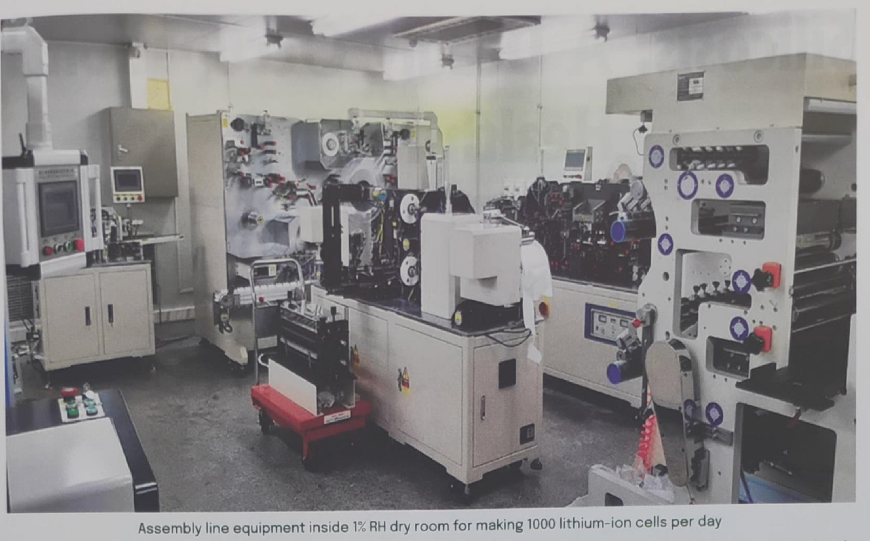
- A key goal of the ICeNGESS project is to establish a thriving indigenous lithium-ion battery ecosystem.
- This involves nurturing startups through technical incubation, fostering collaborations between research institutions and industries, and supporting innovation.
- By bridging the gap between research and commercialization, the project drives economic growth and job creation.
Vision for 2030: Self-Reliance in Energy Solutions
- Since its launch in 2022, the project has made steady progress, with plans for large-scale production in Phase Two by 2025. By 2030, India aims to achieve self-reliance in lithium-ion battery technology, positioning itself as a global leader in sustainable energy solutions. This initiative aligns with India’s vision for a cleaner and more energy-secure future.
Inspiring Global Sustainability
- The success of the ICeNGESS project underscores India’s growing scientific and technological capabilities.
- It serves as an inspiration for other developing nations striving for self-reliance in clean energy solutions.
- By fostering innovation and promoting sustainability, the project lays the groundwork for a brighter and more sustainable future, positioning India as a key player in the global shift towards clean energy.
ARTICLE 11
Silicosis: A Deadly Occupational Health Hazard
Causes of Silicosis
- Silicosis is a chronic lung disease caused by the inhalation of Respirable Crystalline Silica (RCS) particles, which are small enough to penetrate deep into the lungs.
- These particles cause inflammation, scarring, and damage to lung tissue. Workers in industries such as mining, construction, sandblasting, ceramics, foundries, abrasive blasting, and quarrying are particularly at risk due to high exposure to silica dust during activities like drilling, blasting, grinding, and manufacturing.
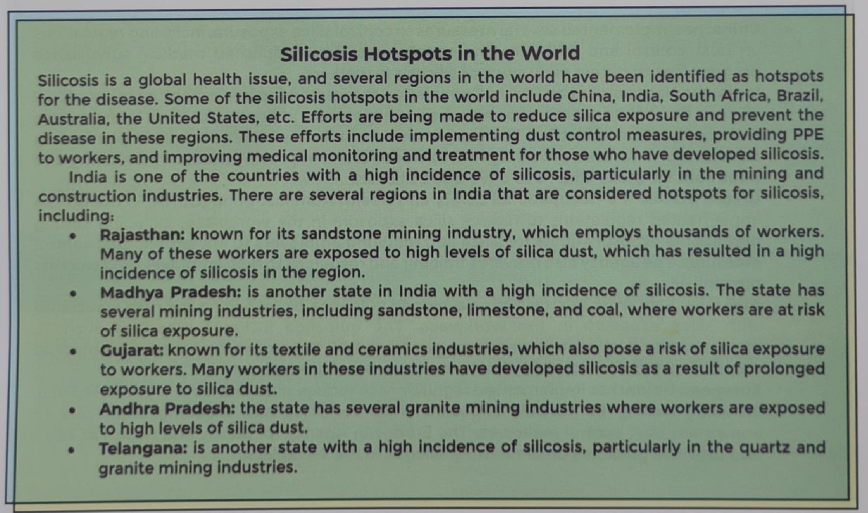
Symptoms of Silicosis
- The symptoms of silicosis develop gradually, ranging from coughing, shortness of breath, and fatigue in the early stages to severe complications like difficulty breathing, chest pain, and respiratory failure in advanced stages.
- Additionally, silicosis can lead to tuberculosis, heart failure, kidney failure, and lung cancer, making it a potentially life-threatening condition.
Development of Silicosis
- The disease develops when lung immune cells, especially macrophages, attempt to engulf silica particles.
- These particles resist breakdown, triggering prolonged inflammation and immune responses.
- Over time, silica particles stimulate the release of inflammatory cytokines, attract other immune cells, and cause lung tissue scarring.
- This results in the formation of fibrotic nodules that impair lung function and exacerbate symptoms.
Diagnosis of Silicosis
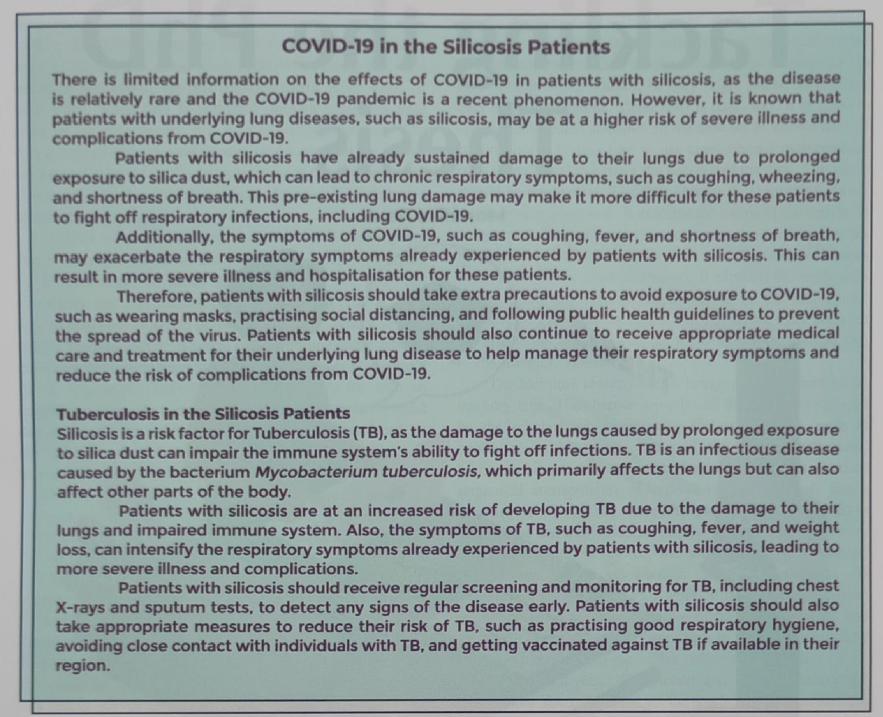
- Silicosis is diagnosed through a combination of methods, including medical history review, physical examination, chest imaging, and lung function tests.
- Early detection is crucial for managing the disease effectively and slowing its progression.
Treatment of Silicosis
While there is no cure for silicosis, several treatments can manage symptoms and improve quality of life:
- Oxygen therapy: Enhances oxygen supply for patients with breathing difficulties.
- Bronchodilators: Relieve symptoms by relaxing airway muscles.
- Corticosteroids: Reduce lung inflammation but may have limited effectiveness.
- Pulmonary rehabilitation: Combines exercise, breathing techniques, and education to improve lung function and overall well-being.
- Lung transplant: Considered for severe cases where lung damage is irreversible.
Prevention of Silicosis

Preventing silicosis involves minimizing exposure to silica dust through the following measures:
- Engineering controls: Use of wet methods, vacuum systems, and dust suppression techniques to reduce dust levels.
- Personal Protective Equipment (PPE): Provision of respirators and protective clothing to safeguard workers.
- Work practices: Implementation of proper ventilation, dust control measures, and worker training on safe practices and PPE usage.
- Medical monitoring: Regular lung function tests and chest X-rays for early detection among at-risk workers.
- Regulations: Enforcement of exposure limits and mandatory safety protocols by governments.
- Education and awareness: Training programs to inform workers about silica risks and preventive measures.
ARTICLE 12
Shrimps that can see more colours than humans
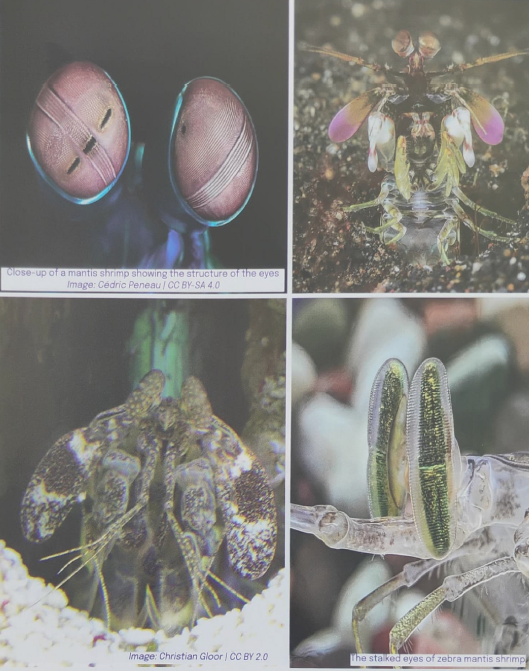
Unique Characteristics of Mantis Shrimps
- Mantis shrimps, found in tropical and subtropical waters of the Indian and Pacific Oceans, are remarkable carnivorous crustaceans known for their vivid colors and complex visual systems.
- Commonly referred to as “prawn killers” in Australia and “thumb splitters” in the Caribbean, these creatures stand out due to their ability to perceive a broad spectrum of light wavelengths, including ultraviolet light.
Extraordinary Vision System
- The mantis shrimp’s visual capabilities surpass most creatures in the animal kingdom.
- While humans have three types of photoreceptor cells, mantis shrimps possess more than 16 types of photoreceptor cells.
- This unique adaptation allows them to see a wider range of the light spectrum, including polarized light.
- This ability aids them in communication, navigation, and hunting, as they can detect camouflaged prey by identifying the polarized light reflected from their bodies.
- Scientists have discovered that the nanoscale arrangement of photoreceptors in their eyes enables this remarkable feature.
Spectral Tuning and Colorful Appearance
- Some species of mantis shrimps exhibit spectral tuning, which allows them to adjust their sensitivity to long-wavelength colors based on their environment.
- These crustaceans can grow to lengths of 10 to 38 cm and display vibrant colors, making them visually striking.
- Their stalked eyes can move independently, providing a wide field of vision and exceptional precision in scanning their surroundings.
Scientific Inspiration
- The complexity of mantis shrimp vision has inspired researchers to develop advanced imaging technology.
- Cameras modeled after their eyes have potential applications in early cancer detection and monitoring underwater creatures that communicate using signals invisible to standard cameras.
- These innovations highlight the scientific importance of understanding mantis shrimp biology, offering insights that could revolutionize various fields.
NEWS IN BRIEF
Web slinging technology

- Researchers at Tufts University have developed a web-slinging technology that mimics Spider-Man’s iconic superpower.
- This device shoots a fluid material from a needle, which instantly solidifies into a string capable of adhering to objects and lifting them.
- The fibers, derived from silk moth cocoons, can vary in diameter based on the needle’s bore, reaching up to half a millimeter.
- Remarkably, the technology can lift objects over 80 times its own weight, showcasing its strength and potential applications.
- The breakthrough is detailed in the journal Advanced Functional Materials.
The grain size soft robots for targeted drug delivery

- Researchers from Nanyang Technological University, Singapore, have developed grain-sized soft robots that can be controlled using magnetic fields.
- These highly dexterous robots can roll, crawl, and navigate complex environments, making them suitable for use inside the human body.
- Capable of transporting and releasing up to four drugs in programmable sequences, the robots are made from non-toxic smart magnetic composite materials.
- This innovation, published in Advanced Materials, promises significant advancements in targeted drug delivery and medical therapies.
A device to capture water directly from air in low humidity

- Researchers from the University of Nevada, Las Vegas, have developed a solar-powered water-capturing device designed for arid regions.
- The device can efficiently extract water from the air even in low humidity levels of 10%.
- It uses a liquid salt solution to capture water, which can then be processed for drinking and energy production.
- This innovation offers a promising solution to water scarcity in arid regions, combining efficiency with sustainability. The study was published in Proceedings of the National Academy of Sciences (PNAS).
- Researchers at IISC developed a nanomaterial-based solution for removing heavy metal contamination
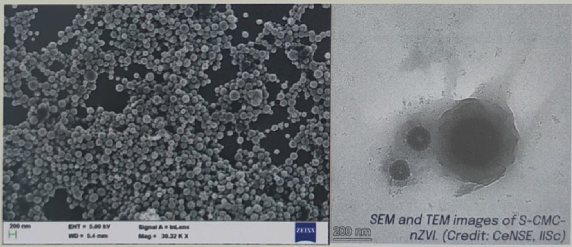
- Researchers at the Indian Institute of Science (IISc) have developed a nanomaterial-based solution to address heavy metal contamination in groundwater.
- Unlike conventional methods that require water to be pumped out for treatment, this on-site approach involves injecting iron nanoparticles directly into the groundwater to remediate contaminants like chromium.
- This innovation provides an efficient alternative to traditional purification techniques.
- The study is published in the Journal of Water Process Engineering.


